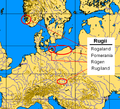 | between the Chernyakhov culture and the Wielbark culture, which was located closer to the Baltic Sea. The Chernyakhov culture encompassed regions of modern... 18 KB (2,077 words) - 23:17, 2 May 2024 |
 | they are associated with the archaeological Wielbark culture. From the 2nd century, the Wielbark culture expanded southwards towards the Black Sea in... 173 KB (18,811 words) - 22:38, 5 May 2024 |
Wielbark may refer to: Wielbark culture, part of an Iron Age archaeological complex in northern Europe Wielbark, Pomeranian Voivodeship, a village in... 478 bytes (84 words) - 14:26, 26 November 2023 |
Gutones (section Wielbark culture) these two groups of peoples, generally equated to the Wielbark culture and Chernyakhov culture respectively, show signs of significant contact. There... 15 KB (1,700 words) - 02:25, 3 December 2023 |
 | eastern area was subsequently absorbed by the Wielbark culture and Chernyakhov culture. The Przeworsk culture people lived in small, unprotected villages... 13 KB (1,452 words) - 08:28, 16 March 2024 |
 | Berig (section In popular culture) research indicates, however, that the transition of the Oksywie culture into the Wielbark culture was peaceful and its timing coincides with the appearance... 3 KB (325 words) - 07:17, 26 December 2023 |
the 1st century a new culture appeared at the mouth of the Vistula, called the Wielbark Culture replacing the local Oksywie culture. The most salient component... 7 KB (937 words) - 22:44, 25 March 2023 |
found in the territory historically settled by the Goths (Wielbark culture, Chernyakhov culture). Due to the early Christianization of the Goths, the Gothic... 6 KB (699 words) - 05:38, 4 February 2024 |
 | Ostrogoths (section Culture) Teia(s), Teja) r. 552–553 List of Germanic tribes Crimean Goths Oium Wielbark culture A language related to Gothic was still spoken sporadically in Crimea... 58 KB (8,019 words) - 12:09, 18 April 2024 |
 | 're-arranged' into the so-called Kyiv culture, whilst the westernmost areas were integrated into the Wielbark culture. Tarasov I. The Balts in the Migration... 7 KB (577 words) - 23:16, 2 May 2024 |
connection between the Wielbark and Sântana de Mureș-Černjachov cultures, archaeologists note that the Wielbark material culture spread southwards in the... 22 KB (3,074 words) - 23:33, 2 December 2023 |
Germanic migration to that area resulted in the formation of the Wielbark culture, which is associated with the Goths. I1-Z63 has been traced to the... 69 KB (5,738 words) - 17:56, 26 April 2024 |
 | Marcomannic Wars (section In popular culture) south-east from their ancestral lands at the mouth of River Vistula (see Wielbark culture), putting pressure on the Germanic tribes from the north and east.... 26 KB (2,927 words) - 02:20, 20 March 2024 |
souls of men. Remains of dogs found in grave sites of the Iron Age Wielbark culture, and dog burials of Early Medieval North-Western Slavs (in Pomerania)... 22 KB (2,341 words) - 15:49, 10 April 2024 |
 | the Gothic Wielbark culture (Poland) had indeed moved and settled in Ukraine and mixed with the previous populations of the Zarubintsy culture, where they... 2 KB (259 words) - 04:41, 25 January 2023 |
 | The Kyiv culture or Kiev culture is an archaeological culture dating from about the 3rd to 5th centuries, named after Kyiv, the capital of Ukraine. It... 3 KB (344 words) - 02:42, 28 February 2024 |
 | Silesians and Pomeranians. These five tribes "shared fundamentally common culture and language and were considerably more closely related to one another... 5 KB (540 words) - 21:19, 21 January 2024 |












